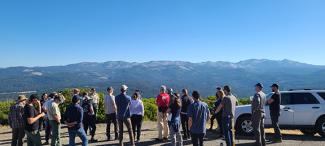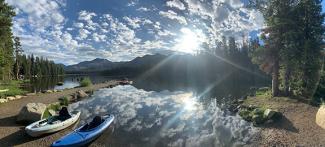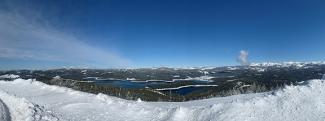HELP's in the Name — Healthy Eldorado Landscape Partnership
Margalit Shetreat-Klein, Pacific Southwest Region
April 19th, 2024

The Eldorado National Forest is a hub for hundreds of thousands of nature lovers every year. Besides holding a special place in the hearts of visitors for its diverse recreation, the forest also provides drinking water and hydroelectric power to millions in the region. And intermixed with all this, you’ll find cultural sites and critical habitat for native wildlife and plants.
But like many areas throughout California, the landscape of the Eldorado National Forest faces unprecedented challenges from devastating wildfires like the King Fire in 2014, Caldor Fire in 2021, and Mosquito Fire in 2022.
Negative impacts from fire — along with too-dense forests, drought, and tree deaths — put these crucial resources at great risk. Add to that funding competition, lack of local wood processing infrastructure, and limited staff capacity. This is a multidimensional problem that needs a dynamic, strategic approach to solve.
That’s where HELP comes in.
A beacon of collaboration and innovation on the forest, the Healthy Eldorado Landscape Partnership (HELP) formed in 2021 as a pilot partnership on the Eldorado National Forest. Recognizing an urgent need, former Eldorado National Forest Supervisor Jeff Marsolais gathered up partners to expedite landscape-scale project development .
Of course, these are goals many landscape managers in California share.
So, what makes HELP different?
Working from a Shared Vision

HELP site visit in Oct. 2022 at the Big Hill Lookout, Eldorado National Forest. This overlooks some of the remaining unburned mature forest landscapes in the Crystal Basin focus area. (USDA Forest Service photo by Dana Walsh)
In a more traditional partnership model, individual partners handle single projects on different parts of the landscape. Great work can be done this way. But ultimately, each partner works on just a piece of the puzzle.
HELP works differently, bringing partners together for shared stewardship. Eldorado Forest Supervisor Joe Stout and staff provide overall direction on regional and forest priorities.
“HELP is supporting projects on the forest and bringing additional capacity and resources,” Stout explained. “This leads to greater outcomes at an accelerated rate.”
Through HELP, the forest and trusted partners plan, fund and carry out a shared vision. The group meets every month, with smaller workgroups diving deeper into specific project pieces.
HELP’s collaborators bring their experiences to help with steps that can be difficult for a partner to navigate alone. Some folks have expertise in financial sourcing or engagement. Others in project planning and implementation. And still others share grant writing or stewardship agreements skills.
Funding Large Projects

Wrights Lake in the Crystal Basin attracts kayakers and other recreational tourism. Fuel reduction treatments and recreation improvements are planned for this area from 2025 to 2027. (USDA Forest Service photo by Nicholas Trigueiro)
Before HELP, most partners sought funding on an individual project or portion of a project with the forest. Partners often competed for grants with other partners. The process could be lengthy and left gaps between projects — making it harder to achieve effective, long-term work.
To combat this, HELP is creating a portfolio of projects on priority landscapes. The goal? Use current and other funding sources to fill in gaps and link work plans. This moves projects forward quickly and achieves healthy forests on a landscape scale.
One such standout is HELP’s Crystal Basin Ecological Restoration Project, a gateway to the popular Desolation Wilderness. This area is filled with critical public infrastructure, unburned forests, cultural sites, critical habitat, reservoirs, hydroelectric power generation facilities, and recreation. It’s also at high risk of detrimental wildfire.
In 2023, HELP received $10 million in grants for work on the Crystal Basin — a big change from HELP’s previous management of only a few $100,000. They were selected for the Sierra Nevada Conservancy’s Landscape Grant Pilot Program. These funds from CAL FIRE, Forest Service, and Sierra Nevada Conservancy will begin restoration work on several current and future National Environmental Policy Act (NEPA) projects that make up the Crystal Basin project. At the same time, HELP is already exploring additional funding to fill gaps and developing grant proposals for the next phases.
“In this way, we’re achieving landscape-scale projects by continuously leveraging our funding sources, which makes us more competitive,” explains Michelle Wolfgang, Eldorado National Forest partnership coordinator. “Because we’re showing we can plan and implement the work, while handling the hefty workload that comes with multimillion-dollar grants.”
And organizations lending the money like knowing their investments will have the greatest impact as adjacent landscapes are being treated. This allows HELP’s grant applications to become even more competitive.
Financing Conservation Just Got Better Together

Big Hill Lookout at Union Valley Reservoir in the heart of the Crystal Basin. As the largest lake in the area, this popular recreation destination also provides hydroelectric power. Phase I of the Crystal Basin Ecological Restoration Project will go through 2028. (USDA Forest Service photo by Nicholas Trigueiro)
Conservation finance refers to the blending of public and private dollars to accelerate the pace and scale of conservation projects using shared stewardship. From the outset, HELP has been working to create a conservation finance framework that brings established funding partners and private stakeholders around a shared interest of protecting the forest.
“It’s taking a larger, zoomed out perspective of who uses the forest and what benefit a healthy forest provides,” said Zach Browning, HELP collaborator and shared stewardship advisor for the Forest Service’s Central Sierra Zone. “It really is bringing folks to the table who need to be at the table.”
For example, water from the national forest goes downstream to generate hydropower and clean water. Yet end users – utility and water districts and power companies – don’t always invest in the landscape upstream. But they rely on avoiding the impacts of fire on clean water and hydropower.
HELP’s Conservation Finance Workgroup aims to get these beneficiaries interested in financing projects that create a forest more resilient to the negative impacts of inevitable fires.
“We talk a lot about avoided cost,” said Sabrina Chui, project associate for Blue Forest, a HELP collaborator in the Conservation Finance Workgroup. “Because if you've done the work, when fire comes, instead of getting a high-severity fire, you’ll likely get a low- to moderate-severity fire. And so with avoided costs — avoided damage to infrastructure and power lines and increased hydropower generation — they [the beneficiaries] give dollars to the landscape. And they reap it back in terms of reduced risk and additional water.”
And while a conservation finance model for the entire forest isn’t launched yet, progress is chugging along. In 2023, The Freshwater Trust, HELP collaborator and member of the Conservation Finance Workgroup, received an Innovative Finance for National Forests grant to support the Cosumnes Watershed Outcome Bank. HELP’s Conservation Finance Workgroup is hard at work quantifying benefits of project activities and developing beneficial partnerships.
Next Steps for HELP
HELP continues creating a portfolio of shovel-ready projects, backed by a sustainable financing strategy to implement those projects.
To date, the Forest Service has identified over $70 million shovel-ready forest health and fuels reduction activities in the Crystal Basin. HELP collaborator The Great Basin Institute will break ground in spring 2024 on several thousand acres of additional treatment in the landscape.
Additionally, through HELP, American Forests, American Rivers, and The Great Basin Institute have aligned to support grant applications on post-fire reforestation and watershed recovery in the Consumnes River watershed. This work would involve multiple partners to reforest and restore watersheds affected by the Caldor Fire and provide co-stewardship support for Tribes.
HELP envisions a resilient Eldorado National Forest, where the success achieved so far is a steppingstone to a sustainable future. Wolfgang sums up the impact of these HELP partnerships for the Forest Service:
“HELP is an orchestra of partners, each providing their unique perspectives, skills and expertise to the work we do. We create a symphony of well-timed and well-executed phased project planning and implementation.”


